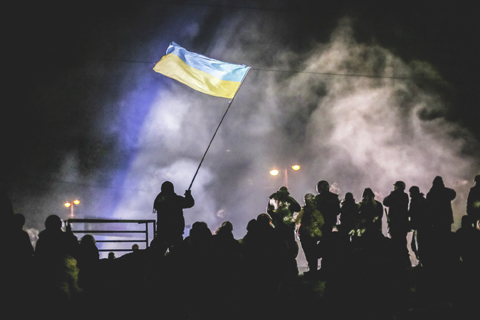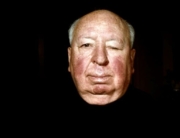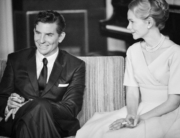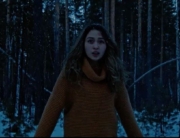![]() This revolution was televised. Winter on Fire: Ukraine’s Fight for Freedom opens on Day 92, February 20, 2014, with a reporter in a makeshift helmet ducking after shots ring out, before he plunges in to help drag bodies away from the chaotic streets of Kiev. Such vivid coverage was enough to get more people out of their homes and into the streets to support demands for a pro-European democracy—in near zero weather. Director Evgeny Afineevsky’s team, with dozens of cameras, became even more intimately embedded alongside protesters day by day, facing snow and government attacks to tensely follow the complicated story through the eyes and actions of diverse, eloquent participants during the 94-day mobilization.
This revolution was televised. Winter on Fire: Ukraine’s Fight for Freedom opens on Day 92, February 20, 2014, with a reporter in a makeshift helmet ducking after shots ring out, before he plunges in to help drag bodies away from the chaotic streets of Kiev. Such vivid coverage was enough to get more people out of their homes and into the streets to support demands for a pro-European democracy—in near zero weather. Director Evgeny Afineevsky’s team, with dozens of cameras, became even more intimately embedded alongside protesters day by day, facing snow and government attacks to tensely follow the complicated story through the eyes and actions of diverse, eloquent participants during the 94-day mobilization.
The English narration tracks back to when President Viktor F. Yanukovych returned to power in 2010, after “the Orange Revolution” had peacefully and successfully pressed for his rigged 2004 election to be overturned. By November 2013, students were demonstrating in the central Maidan Square to insist the government move forward on promises to begin the steps toward European Union membership. Yanukovych instead signed a secret protocol with Russia.
Afineevsky and his co-producer Den Tolmor, both born in the former Soviet Union, first followed the student protests on social media. They arrived at the square in time to capture the outrage at parliament for reneging on promises, such as from the disgusted middle-aged doctor: “They stole our children’s future.” Facebook posts called for a rally on November 21, and a few hundred gradually grew to several thousands. They stayed through the night, and the rain. (Vitali Klitschko, the boxer brother who is not married to Hayden Panettiere but a leader of an opposition party, was rebuffed for trying to use the movement for political gain.)
By day nine, the president’s counter intentions are clear, and festive chants turn to boos. Police in riot gear surround the square: the Berkut special security forces, who appear and act a lot like Star Wars stormtroopers. They systematically chase and viciously strike the protesters with batons–metal ones, a witness remembers. Fallen bodies are kicked repeatedly and blood streams down battered heads. On the run, the camera can barely keep up with the violent mayhem (some photographers in the crew were injured).
So far, it looks like a familiar pattern of youthful rebellion against an authoritarian state, with both sides ratcheting up the pressure. The next morning, St. Michael’s gold domed monastery provides shelter for the activists. Other religious leaders arrive to bless the packed crowd, including an imam, and to defy the president, and gates are locked against the police. All ages, from different cities and ethnicities march the next day in protest. (A bright, lively 12-year-old Roma boy cuts school to get quite a political education.) They fill the streets to take back Maidan Square in the name of European values of freedom and dignity. (Throughout, maps helpfully pinpoint movements as urban warfare.) The authorities counter with huge construction vehicles to push the crowd, and the Berkut release loud stun grenades, seeming to target medics for beatings.
Each time the government attacks escalate, more supporters come into the streets. The demonstrations prod the European Union to send negotiators urging dialogue, but that just leads to the government literally digging in to clear the square. Thousands pour into the street to push back while the president’s meeting with Putin is broadcast on a big screen. Parliament passes a stream of regulations to stop the protests, and a march on the legislature is attempted, with demonstrators wearing pots on their heads to defy a ban on protective helmets.
Both sides get angrier, and the protesters receive tactical defensive help from military reservists to build heavier barricades and to strike back. (Jasha Klebe’s score is refreshingly nonbombastic during the clashes, with the emphasis on Edvin Marton’s moving solo violin on a Stradivarius.) Mercenary thugs, called titushky, are sent in; the demonstrators claim they are criminals released from prison. In interviews, the titushky insist they’re keeping the peace—even when they strip a protester naked to humiliate him. Then come the snipers with real bullets (bullet holes mark buildings). In the aftermath of the battles (seen in frightening close-up), the first two young men killed become martyrs for the people to rally around with even more determination. Open casket funerals bring out more protesters and harden their position to demand the president’s resignation and new elections.
The filmmakers consider this “a cultural memorial” for people power. Their film has more immediacy than The Singing Revolution (2007), which looked back at the successful 1991 protests in Estonia, and is ultimately more hopeful than The Square (2013), which reflected more on the initial euphoria of the Arab Spring in Egypt than its ultimate defeat. Many countries are still pressing sanctions against Russia for the takeover of Crimea in southern Ukraine (while this film was being completed) and subsequent covert incursions into the Ukraine’s eastern regions (where 6,000 have been killed—so far). This powerful documentary puts faces and feelings onto distant politics and provides vital background on what’s at stake for the people of Ukraine. A final scroll tallies the toll during the 94 days: 125 killed, 65 missing, almost 2,000 injured.







Leave A Comment